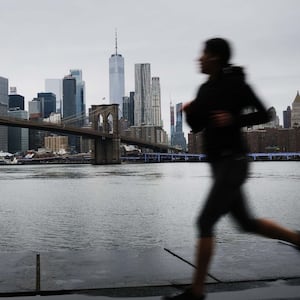Over the last 24 hours, more than 800 New York State residents have died of the novel coronavirus—the largest single-day death toll since the first known infection last month, officials said Thursday.
Despite the devastating death count, New York Gov. Andrew Cuomo said that the Empire State officially saw a “flattening of the curve” in the last day, as the rate of hospitalizations continues to plateau.
“We are flattening the curve by what we’re doing and we’re flattening the curve so far,” Cuomo said. “This is all a direct result of our actions. If we stop acting the way we are acting, the numbers will go up.”
In New York City, the epicenter of the pandemic in the United States, 4,426 people have died and 84,373 more have been infected, according to the city’s Department of Health. Across the state, more than 7,067 have died and 151,079 more have been infected, Cuomo said.
“We lost more lives yesterday than we have to date,” Cuomo said, adding that “9/11 was supposed to be the darkest dark for a generation.” “There was no explosion, but it was a silent explosion that just ripples through society with the same randomness, the same evil that we saw on 9/11.”
Cuomo stressed that while Wednesday was the state’s “deadliest day,” New York is seeing a decreased rate in the number of hospitalizations and the rate of ICU admissions. The new deaths are a result of lagging hospitalization figures from patients who have succumbed to the virus after falling sick weeks ago, he said.
On Thursday, New York City Mayor Bill de Blasio also urged residents to remain “disciplined” about social distancing to continue to curtail the spread of the coronavirus. He said that despite the reality that New Yorkers are going to see a “long tough April,” the future of “the promised land of low-level transmission” is in sight for the city.
“We can say it’s time to start planning for the next phase,” de Blasio said, before warning that “letting the foot off the gas” could result in even tougher restrictions.
Cuomo reiterated the mayor’s plea, stating that over the last 18 days of the state’s “pause” 18,000 New Yorkers have been hospitalized—despite early projections that went as high as 136,000 hospitalizations. But he warned that “if we stop acting the way we are acting those numbers will go up.”
“Even after we get through this battle, we have this war,” Cuomo added, stating that projections suggest New York will see additional waves of the virus. “We can’t handle worst-case scenarios, we can’t even handle a moderate-case scenario.”
“So it’s essential that we keep flattening that curve because we don’t have that option,” he said.
Cuomo said the state will continue to push for more testing that will ultimately allow residents who have already had the virus, or are immune to it, to return back to public life. The governor has previously stated that the New York State Department of Health has already developed a COVID-19 antibody test and that state officials are now working with the FDA to get it approved and bring it to scale across the tri-state area.
On Thursday, Cuomo again stressed the need for rapid testing, asking New Yorkers who have recovered from the coronavirus to give blood, a measure that could also help the state continue to develop a plasma treatment for infected patients.
On the ground, Cuomo said that he has opened additional testing sites in predominantly black and Latin neighborhoods across the state—communities that have been hardest hit by the virus.
According to the New York City Department of Health and Mental Hygiene, Queens is the “epicenter of the epicenter” with more than 7,000 cases in a seven-square-mile stretch in the New York City borough.
The true death-toll number for the area, which is filled with minority communities, is expected to surge in the coming days, however, as officials will begin to include people who have died at home from suspected COVID-19 complications despite not getting an official test. While those at-home deaths were not initially included in the death count, the city’s health commissioner said Thursday that officials are “committed” to ensuring they are counted.

Drone pictures show bodies being buried on New York's Hart Island where the department of corrections is dealing with more burials overall, amid the coronavirus disease.
REUTERS/Lucas JacksonOfficials, however, stressed Thursday that with New York’s rising death toll, the state needs to focus on how to address the bodies that have already overwhelmed hospitals and morgues.
The surge has forced city officials to consider a devastating contingency plan: temporary mass burials of coronavirus patients on Hart Island.
“For decades, Hart Island has been used to lay to rest decedents who have not been claimed by family members,” a city hall spokesperson told The Daily Beast. “We will continue using the Island in that fashion during this crisis and it is likely that people who have passed away from COVID who fit this description will be buried on the Island in the coming days.”
Drone photos taken by Reuters show several workers clad in hazmat suits placing wooden caskets into mass burial plots in potter’s field, which has been used by the city for the past 150 years.
On average, about 25 bodies are buried at Hart Island every week by Rikers Island jail inmates, according to the Hart Island Project. Over the last month, the number of bodies that have not been claimed has spiked—prompting an average of 24 burials a day, the New York Department of Corrections told The Daily Beast.
Burial operations, a task that typically occurred once a week, has now increased to five days a week. Due to social distancing and safety concerns, city officials have hired contract workers to “perform this important work” instead of inmates, DOC Press Secretary Jason Kersten told The Daily Beast.
Meanwhile, the city’s Office of the Chief Medical Examiner made a policy change to its website, stating that the city will only “provide temporary storage of a decedent for up to 14 days.” The website also stated that bodies that are not claimed within the new time frame would be sent to Hart Island.
“As we aim to accommodate the many New Yorkers who have been impacted by the COVID-19 pandemic, the New York City Office of Chief Medical Examiner (OCME) will provide temporary storage of a decedent for up to 14 days,” the website states. “We continue to work with families to accommodate their needs during this difficult time.”
A spokesperson for the chief medical examiner’s office confirmed that the city burial policy changed on Thursday, adding that the office is “adhering to our standard 14-day OCME storage policy for all cases.”
To further combat the increase of deaths related to the coronavirus, Cuomo said Thursday additional funeral directors are now being brought in to relieve hospitals, make-shift morgues, and funeral homes. Additionally, 45 refrigerated trucks have been set up across the five boroughs, some of which are already full, and a temporary morgue has been erected outside Bellevue Hospital in Midtown Manhattan.
The Federal Emergency Management Agency said last week that New York will also receive 250 ambulances, about 500 EMTs and paramedics, and 85 more refrigerated trucks to help with the overload.









